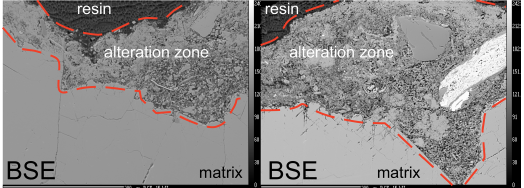Element Mapping
Some XRF spectrometers are equipped with a motorized stage, allowing 2D scanning of objects, provided that the surface investigated is flat enough (the distance to the sample, i.e. focus, is usually fixed at the beginning of the scan). The spatial resolution is determined by the beam size and step between two consecutive measurements, and the spectral resolution by the time of each measurement. This way, a 2D map is obtained, with an XRF spectrum associated with each pixel. After the scan, elements of interest can be selected to have their concentration mapped. This allows the attribution of mapped elements to specific features of the objects investigated, such as colour (pigment identification), ink (presence of metals or other elements), materials used for repairs, etc. Finally, elemental mapping can also be used to recover lost writing, as in some cases, even when the ink is no longer visible on the surface, some of its elemental components can still be present in the writing support. Mapping the concentration of these elements will then make the text readable again, provided that the spatial resolution is good enough.
At the CSMC laboratory, elemental maps can be obtained with Elio (up to 10*10 cm, minimal spot size 1 mm), Crono (up to 60 x 45 cm, minimal spot size of 0.5 mm) and M6 JetStream (up to 80*60 cm, minimal spot size 50 µm).
For a more detailed 2D scanning of smaller objects with a maximum size of 3x3x2 cm, electron microscopes such as SEM can be used for elemental mapping, as they can provide useful surface information of the analysed sample in terms of topography and chemical composition. In particular, SE and BSE images are the two types of electron maps that van be acquired by a SEM analysis. The major difference between those two types of scattered electrons is the elastic (in the case of BSE) versus inelastic (in the case of SE) interaction of the accelerated electron beam with the studied sample. Particularly, BSE images derive from deeper regions of the analysed sample, thus being highly sensitive to differences in the atomic number of the elements present in the sample; as a general rule brighter colour means heavier element. Meanwhile, SE originate from shallower regions of the analysed object surface and are therefore more suitable for topographic information.

CSMC
